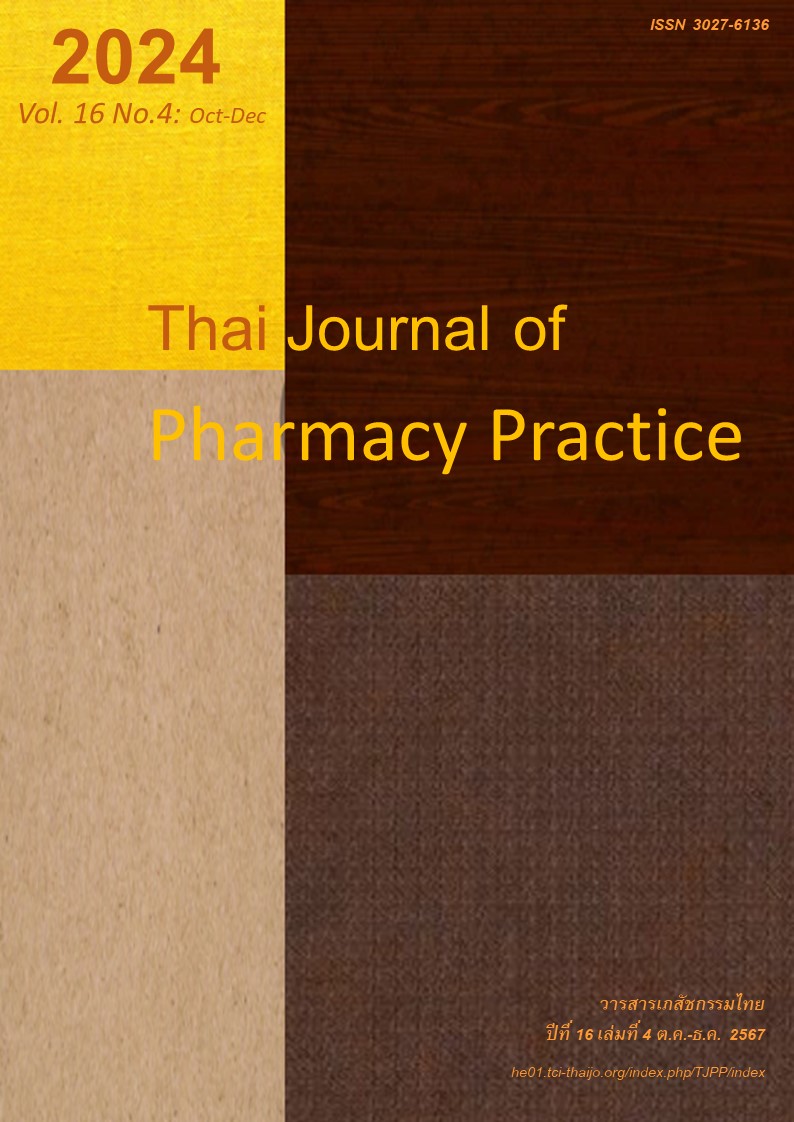ความหมายของยาในมุมมองของผู้ป่วยโรคเบาหวานและโรคความดันโลหิตสูง: กรณีศึกษาจังหวัดพิษณุโลก
Main Article Content
บทคัดย่อ
วัตถุประสงค์: เพื่อทำความเข้าใจความหมายของยาที่ใช้รักษาในมุมมองของผู้ป่วยโรคเบาหวานและโรคความดันโลหิตสูง วิธีการวิจัย: การศึกษานี้เป็นการวิจัยเชิงคุณภาพที่เก็บข้อมูลด้วยการสัมภาษณ์เชิงลึก การคัดเลือกผู้ให้ข้อมูลสำคัญใช้วิธีการเลือกแบบเจาะจงจากผู้ที่ป่วยด้วยโรคเบาหวาน และโรคความดันโลหิตสูงอย่างน้อย 1 ปีและมีรายการยาที่ใช้รักษาประจำอย่างน้อย 2 รายการ ในเขตอำเภอบางกระทุ่มและอำเภอเมือง จังหวัดพิษณุโลก ผู้วิจัยเก็บข้อมูลจนเกิดความอิ่มตัวโดยมีผู้ให้ข้อมูลสำคัญจำนวน 31 คน การศึกษาดำเนินการระหว่างเดือนมกราคม พ.ศ. 2565 ถึง ธันวาคม พ.ศ. 2565 การวิเคราะห์ข้อมูลใช้วิธีการวิเคราะห์แก่นสาระ (thematic analysis) ผลการศึกษา: ผู้ให้ข้อมูลสำคัญส่วนใหญ่เป็นเพศหญิง (ร้อยละ 74.19) อายุเฉลี่ยเท่ากับ 66.16 ± 8.90 ปี ระยะเวลาเจ็บป่วยเฉลี่ย 9.42 ± 4.87 ปี มีรายการยาที่ใช้ประจำ 5.13 ± 1.45 รายการ ผู้ให้ข้อมูลสำคัญส่วนใหญ่ให้ความหมายเกี่ยวกับยาผ่านประสบการณ์ การรับรู้ และความเชื่อของผู้ให้ข้อมูลสำคัญ ยาจึงหมายถึงตัวช่วยควบคุมอาการของโรค บรรเทาอาการเจ็บป่วย ความไม่สบายตัว ความผิดปกติของร่างกาย นอกจากนี้ความหมายของยายังเกี่ยวข้องกับการรับรู้ประโยชน์ ประสิทธิภาพของยา และความกังวลเกี่ยวกับผลกระทบที่เกิดจากการใช้ยา ซึ่งล้วนแต่เป็นเหตุผลสำคัญที่ส่งผลพฤติกรรมการใช้ยา นับตั้งแต่การปรับขนาดยา โดยส่วนใหญ่มักเป็นการลดจำนวนเม็ดยา หรือปรับเวลาในการรับประทานยา และการแสวงหาวิธีการรักษาอื่น สรุป: การศึกษานี้ทำให้สามารถเข้าใจถึงมุมมองของผู้ป่วยโรคเรื้อรังเกี่ยวกับนิยามความหมายของยาที่มีความแตกต่างจากมุมมองของบุคลากรทางการแพทย์ ซึ่งบุคลากรทางการแพทย์ควรทำความเข้าใจความหมายของยาและพฤติกรรมเกี่ยวกับการใช้ยาของผู้ป่วยโรคเรื้อรังให้มากขึ้น เพื่อนำมาใช้ในการวางแผนการรักษาร่วมกับผู้ป่วยต่อไป
Article Details

อนุญาตภายใต้เงื่อนไข Creative Commons Attribution-NonCommercial-NoDerivatives 4.0 International License.
ผลการวิจัยและความคิดเห็นที่ปรากฏในบทความถือเป็นความคิดเห็นและอยู่ในความรับผิดชอบของผู้นิพนธ์ มิใช่ความเห็นหรือความรับผิดชอบของกองบรรณาธิการ หรือคณะเภสัชศาสตร์ มหาวิทยาลัยสงขลานครินทร์ ทั้งนี้ไม่รวมความผิดพลาดอันเกิดจากการพิมพ์ บทความที่ได้รับการเผยแพร่โดยวารสารเภสัชกรรมไทยถือเป็นสิทธิ์ของวารสารฯ
เอกสารอ้างอิง
Buszko K, Obońska K, Michalski P, Kosobucka A, Jurek A, Wawrzyniak M, et al. The Adherence Scale in Chronic Diseases (ASCD). The power of knowledge: the key to successful patient — health care provider cooperation. Med Res J 2016; 1: 37-42.
Mekonnen GB and Gelayee DA. Low medication knowledge and adherence to oral chronic medications among patients attending community pharmacies: a cross-sectional study in a low-income country. Biomed Res Int 2020; 2020: 4392058. doi: 10.1155/2020/4392058.
Clyne B, Cooper JA, Boland F, Hughes CM, Fahey T, Smith SM. Beliefs about prescribed medication among older patients with polypharmacy: a mixed methods study in primary care. Br J Gen Pract 2017; 67: e507-18.
Van der geest S and Whyte SR. The charm of medicines: Metaphors and metonyms. Med Anthropol Q 1989; 3: 345-67.
Sringernyuang L. Socio-cultural dimensions of drug use in the community: development of knowledge from theory and research. Health Systems Research Institute, Ministry of Public Health; 1999.
Jongwilaikasem K, Lerkiatbundit S. Development of the Medication Adherence Scale for Thais (MAST).
Thai Journal of Pharmacy Practice 2021; 13: 17-30.
Chuengsatiansup K, Sringernyuang L, Paonil W. Medication versus community: socio-cultural dimen- sions. Nonthaburi: Society and Health Institute; 2007.
Limdul P. Drug consumer protection in the community. Ang Thong: Ang Thong Provincial Public Health Office; 1991.
Chanthapasa K. Patient insight: reason of patient (did not) take medicines. Khon Kaen: Faculty of Pharmaceutical Sciences, Khon Kaen University; 2021.
Sun H, Saeedi P, Karuranga S, Pinkepank M, Ogurt sova K, Duncan BB, et al. IDF diabetes atlas: Global, regional and country level diabetes prevalence estimates for 2021 and projections for 2045. Diabe- tes Res Clin Pract 2022; 183: 109-19.
Kanchanapibulwong A, Kamwangsanga P, Kaewta S. Situation report on NCDs, diabetes, hypertension and related risk factors 2019. Nonthaburi: Graphic and Design; 2020.
Ruangphaisan M and Chanthapasa K. Reasons for medication non-adherence from the perspective of type 2 diabetic patients: A case study of Warit-Chaphum Hospital, Sakon Nakorn. Thai Journal of Pharmacy Practice 2020; 12: 481-93.
U-ingrai S. Perspective, illness beliefs and self-care behavior among type 2 diabetic patients with third stage chronic kidney disease; case study in sub-district health promoting hospital. Chiangrai Medical Journal 2020; 2: 104-15.
Horne R, Weinman J, Hankins M. The Beliefs About Medicines Questionnaire: The development and evaluation of a new method for assessing the cognitive representation of medication. Psychol Health 1999; 14: 1-24.
Murray MD, Morrow DG, Weiner M, Clark DO, Tu W, Deer MM, et al. A Conceptual framework to study medication adherence in older adults. Am J Geriatr Pharmacother 2004; 2: 36-43.
Horne R. Representations of medication and treat- ment: advances in theory and measurement. In: Petrie KJ, WeinmanJ, editors. Perceptions of health and ill-ness: current research and applications. London: Harwood Academic; 1997.
Woodham N, Taneepanichskul S, Somrongthong R. Medication adherence and associated factors among elderly hypertension patients with uncon- trolled blood pressure in rural area, Northeast Thailand. J Health Res 2018; 32: 449-58.
Desta M, Yibeltal D, Memiah P, Ayenew T, Mulugeta H, Gadefaw M, et al. Antihypertensive medications adherence and associated uncontrolled blood pressure among hypertensive patients in Ethiopia: Systematic review and meta-analysis. Int J Afr Nurs Sci 2022; 16: 100404.
Rubio JS, García-Delgado P, García-Delgado P, Mateus-Santos H, Martínez-Martínez F. Martínez-Martínez. Measurement of patients’ knowledge of their medication in community pharmacies in Portugal. Cien Saude Colet 2015; 20: 219-28.
Simonsen BO, Johansson I, Daehlin GK, Osvik LM, Farup PG. Medication knowledge, certainty, and risk of errors in health care: a cross-sectional study. BMC Health Serv Res 2011; 11: 175. doi: 10.1186/1472-6963-11-175.
Van Der Geest S. Pharmaceutical anthropology: Perspectives for research and application. In: Van Der Geest S, Whyte SR. The context of medicines in developing countries. Dordrecht: Springer; 1988.
Chantra C and Moungkan J. Cause of left over drugs in elderly patients with chronic disease at Ruamjai community health care Wangthong, Phitsanulok Province. The 11th Hatyai National and International Conference; July 17th, 2020; Hatyai University. Songkhla: 2020.
Choowattanapakorn T and Suriyawong S. The view of illness among older persons with diabetes mellitus. Thai Journal of Nursing 2011; 26: 96-107.
Paechaiyaphum N and Theeranut A. Illness percep- tion of diabetic nephropathy among patient with diabetes mellitus type 2. Journal of Nursing and Health Care 2020; 38: 23-31.
Leaungsomnapa Y, Promproh S, Leaungsomnapa S, Sourthao Y. Influence of beliefs about medication on high group of medication adherence in hyper tensive patients. Journal of Prapokklao Hospital Clinical Medical Education Center 2013; 30: 146-57.
Sriprasert D. Medical dominance and the doctor-patient relationship. Thammasat Journal 2018; 37: 78-95.
Wongprasertsuk C, Cheuphudee N, Sathansuk W, Hiranpattanakul C. Drug use behavior of chronic disease patients of the Bang Talad Tambon Health Promoting Hospital. Kuakarun Journal of Nursing 2022; 29: 103-17.
Rosenstock M. Historical origins of the health belief model. Health Education Monographs 1974; 2: 328-35.
Rungsawang S. Factors related to polypharmacy medication adherence among older persons with chronic illness. Journal of Nursing, Siam University 2014; 18: 6-23.


